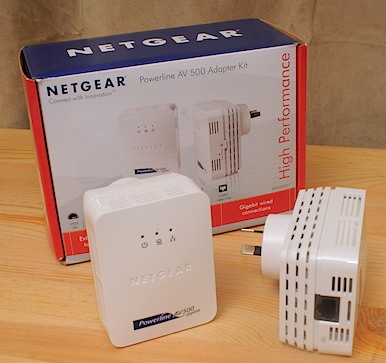The Netgear Powerline AV500 Adapter Kit is an Ethernet over Powerline Adapter. What this means is that, instead of having wires trailing all around your home so that you can have an Ethernet connection in the location that you want it, rather than having it where your modem might be located.
It achieves this by using your home’s existing power line wiring as a means of transmission of the Ethernet signals. It sounds a bit like Voodoo, and it probably is.
But it’s a lot neater than having tangles of wiring all over the place, and it’s also a lot easier to set up – and more secure – than a wireless network will be.
The kit itself is very simple, consisting of a pair of adapters, and a pair of Ethernet cables. Each of the adapters takes the form of the sort of power adapter you’ll already be familiar with – from your phone, your modem, your router, and pretty well a dozen other devices that you’ll be likely to have in your home.

And in terms of setup and usage, that’s pretty much all that you need to do: just plug each of the adapters into a power point, connect the Ethernet cables to your router or modem at one end, and into a device at the other, and you should be good to go.
The AV500 provides up to 1GB throughput. That’s basically in the “fast” bucket, and should be adequate to connect, for instance, your internet connected TV or PVR, and give you an adequate level of bandwidth to download TV programming from the internet (say, YouTube, iiNet’s FetchTV, or the ABC’s iView) and provide you with a satisfactory viewing experience.
My only criticism of this is that, for each adapter, there is only one Ethernet port. While it’s very simple to add to your network capacity by installing a small switch or hub at the adapter, it would also have been a simple exercise for NetGear to have included a four port switch within the basic hardware specification, and thus provide for you to have multiple devices located adjacent to the extended network’s ports.
That point aside, this is a very easy device to set up and use, and as we find our home networks requiring more points of access, this is a very easy way to add an extra point of access, with minimal work, virtually no intrusion into your home, and with good security due to it not being a wireless device.
